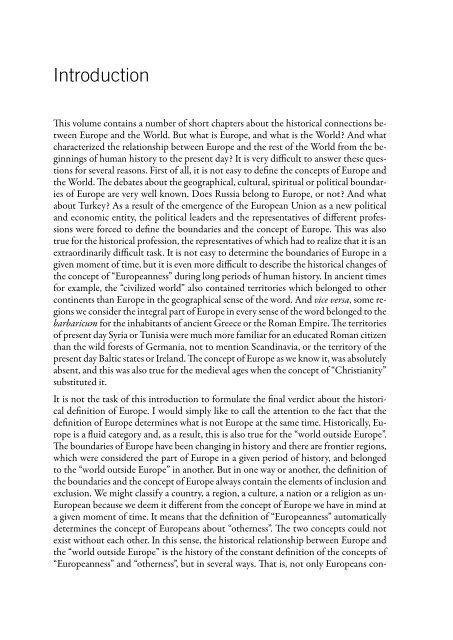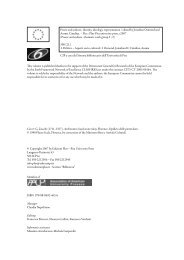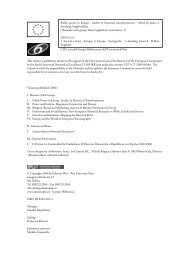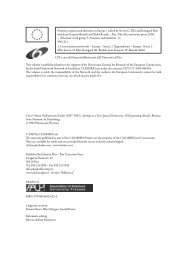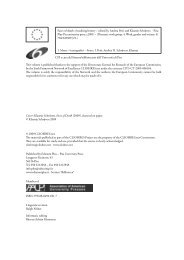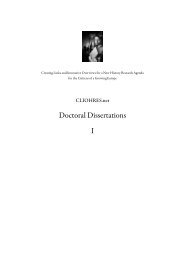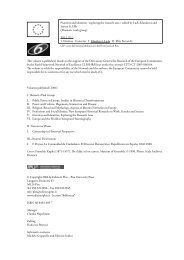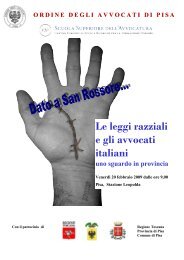Volumes published (2006) I. Thematic Work ... - CLIOHRES.net
Volumes published (2006) I. Thematic Work ... - CLIOHRES.net
Volumes published (2006) I. Thematic Work ... - CLIOHRES.net
You also want an ePaper? Increase the reach of your titles
YUMPU automatically turns print PDFs into web optimized ePapers that Google loves.
Introduction<br />
This volume contains a number of short chapters about the historical connections between<br />
Europe and the World. But what is Europe, and what is the World? And what<br />
characterized the relationship between Europe and the rest of the World from the beginnings<br />
of human history to the present day? It is very difficult to answer these questions<br />
for several reasons. First of all, it is not easy to define the concepts of Europe and<br />
the World. The debates about the geographical, cultural, spiritual or political boundaries<br />
of Europe are very well known. Does Russia belong to Europe, or not? And what<br />
about Turkey? As a result of the emergence of the European Union as a new political<br />
and economic entity, the political leaders and the representatives of different professions<br />
were forced to define the boundaries and the concept of Europe. This was also<br />
true for the historical profession, the representatives of which had to realize that it is an<br />
extraordinarily difficult task. It is not easy to determine the boundaries of Europe in a<br />
given moment of time, but it is even more difficult to describe the historical changes of<br />
the concept of “Europeanness” during long periods of human history. In ancient times<br />
for example, the “civilized world” also contained territories which belonged to other<br />
continents than Europe in the geographical sense of the word. And vice versa, some regions<br />
we consider the integral part of Europe in every sense of the word belonged to the<br />
barbaricum for the inhabitants of ancient Greece or the Roman Empire. The territories<br />
of present day Syria or Tunisia were much more familiar for an educated Roman citizen<br />
than the wild forests of Germania, not to mention Scandinavia, or the territory of the<br />
present day Baltic states or Ireland. The concept of Europe as we know it, was absolutely<br />
absent, and this was also true for the medieval ages when the concept of “Christianity”<br />
substituted it.<br />
It is not the task of this introduction to formulate the final verdict about the historical<br />
definition of Europe. I would simply like to call the attention to the fact that the<br />
definition of Europe determines what is not Europe at the same time. Historically, Europe<br />
is a fluid category and, as a result, this is also true for the “world outside Europe”.<br />
The boundaries of Europe have been changing in history and there are frontier regions,<br />
which were considered the part of Europe in a given period of history, and belonged<br />
to the “world outside Europe” in another. But in one way or another, the definition of<br />
the boundaries and the concept of Europe always contain the elements of inclusion and<br />
exclusion. We might classify a country, a region, a culture, a nation or a religion as un-<br />
European because we deem it different from the concept of Europe we have in mind at<br />
a given moment of time. It means that the definition of “Europeanness” automatically<br />
determines the concept of Europeans about “otherness”. The two concepts could not<br />
exist without each other. In this sense, the historical relationship between Europe and<br />
the “world outside Europe” is the history of the constant definition of the concepts of<br />
“Europeanness” and “otherness”, but in several ways. That is, not only Europeans con-


